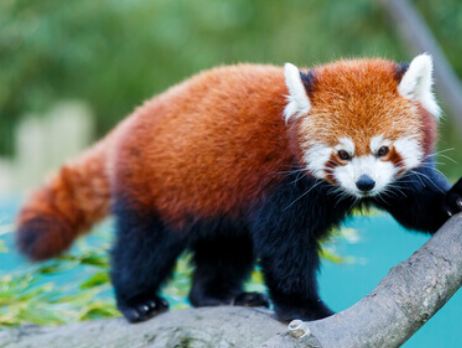Even though it is much less known than its black and white namesake, the red panda has a size similar to that of a domestic cat and a long, thick ringed tail. But despite sharing the same name, geographic spaces and some eating habits as that of the giant that spends all day eating bamboo, the latest scientific research inserts this little animal into an independent family (Ailuridae).

Some information about the red panda
Also known as a panda-small, the animal has a soft, long reddish coat with a white color on the face region and, in addition, has dark marks below the eyes, making them even more similar to raccoons.
The red panda demonstrates a great ability over the trees: it uses the tail to balance its movements and uses its false thumb, which is actually an extension of its bone, to cling to the trees. The animal spends a lot of time under the trees and even spends a lot of hours sleeping.
As your diet is low calorie, your main activities are eating and sleeping. Accustomed to solitude, except during mating seasons, he is more active at night, at dusk and at dawn, which are the times when they go out to get food.
The gestation period of the red panda lasts on average 135 days and the female usually stops 2 pups, but it can have up to four pups. Births occur in the holes of the trees, which have branches and leaves that protect the newborns.
Despite sharing the same name, geographic spaces and some eating habits with the giant that spends the day eating bamboo, the latest scientific research has inserted the panda-red into a family of its own.
Other characteristics of the red panda
We will tell you now some data describing this beautiful little animal:
- Measures between 30 and 60 centimeters;
- Its tail has the length of 28 to 48 centimeters;
- The male weighs 4.5kg to 6.2kg. And the female from 3kg to 4.5kg;
- The coat of the lower part of your body is darker;
- The sole of their legs has a thick coat that protects them against snowy surfaces;
- Their paws are short and black;
- It has retractable claws;
- The head is rounded, with straight ears and of medium size;
- The nose is black and the eyes have a very dark coloration;
- He lives, on average, 14 years;
- Genital maturity is reached at 18 months. Its predators are the snow leopard (Uncia uncia) and the bison (Mustelid).
One curious fact we can mention is that, just like cats, the red panda licks its front paws and then wipes its face.
Geographical distribution and feeding of the red panda
The panda lives in areas with temperate climates ranging from 10 to 25 degrees Celsius. He prefers the mountainous regions populated with forests. Currently, they are:
- In northern Myanmar;
- In central China;
- In the state of Sikhim located in India;
- In Nepal.
However, there is some evidence that, long ago, they inhabited North America.
In addition to bamboo, your diet includes:
- Fruits;
- Nuts;
- Roots;
- Eggs;
- Birds;
- Lizards;
- Insects;
- Small rodents.
The danger of extinction
Sadly, the panda-red is increasingly threatened with its survival for various reasons, and that man is always the main culprit. Deforestation and advances in the cultivated areas, inhabited areas, and animal farms cause, in addition to the devastation of their territory, the losses of their natural sources of food.
The indiscriminate felling also fragments its distribution area. However, these are not the only dangers to which they are exposed. These animals are victims of clandestine hunting, mainly because the hunters extract their skin. In addition, they are hunted to be sold to zoos in various parts of the world, mainly in North America and Europe, places that promote their reproduction in captivity.
Due to these reasons, and despite being a protected species, its original population has declined significantly in recent times. Nowadays it is estimated that there are only about 2,500 animals living in freedom.
